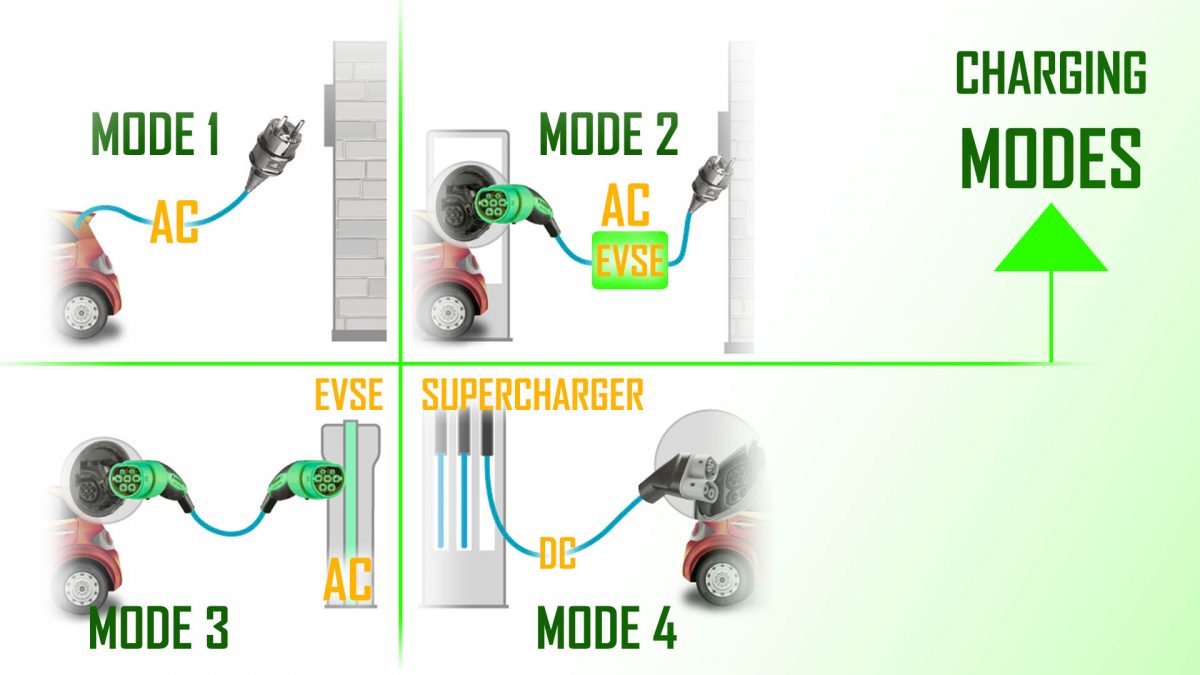EV Charging Modes of Electric Vehicles Explained
There are four Modes of EV Charging exists according to the international standard. What are the main differences between it and what is better and faster for your electric car, read below. Battery charging time described for 50 kWh capacity.
Contents:
Mode 1 EV Charging (AC)
Mode 2 EV Charging (AC, EVSE)
Mode 3 EV Charger (AC, Wallbox)
Mode 4 EV Charger (DC)
What is best
Video EV Charging Modes
Mode 1 (AC, up to 2kW)
Mode 1 charging is almost disappeared because of its disadvantages: its most dangerous and very slow. Electric car connecting to non-dedicated AC wall socket. Maximum output power of charging limited to 2kW (8 amperes).
To charge battery from 0 to 100% is near 40-60 hours required.
Requiremenets
- Wall socket with AC
- Power cord
Mode 2 (AC, output power 3.7kW, EVSE)
EV car charging from non-dedicated alternating current socket, with the only difference EVSE (Electric Vehicle Supply Equipment) control box on the cord. It rectifies from AC to DC and work like circuit breaker.
The most manufacturers put it with the basic equipment for electric car now. Maximum output power is 3.7 kW for 16A socket. About 14-16 hours required for charging full battery capacity.
Requiremenets
- Wall socket with AC
- Power Cord with EVSE controller
Mode 3 (3 phase AC, power up to 43kW, wall EVSE)
Special equipment (like wall charger) can produce 22-43 kW of charging power. Wall box convert AC from three phases to DC. Your power system requires 3-phases with output amperage 20-80A on each line.
This is the best choice for home usage. Battery will charge in 4-9 hours, but before buy external EVSE consult with specialists (what maximum power support your EV’s onboard charger and is your power system support installation).
Requiremenets
- AC with single or three phases with output amperage 16-80A
- Extended EVSE connected to your power system with right fuses
- Onboard charger with support of fast charging
Mode 4 (DC, power up to 800kW, Rapid charger)
The fastest way to charge your EV – use Rapid chargers’ stations (also called superchargers). Fast charging stations very expensive, that is why they almost always public. Not all electric cars support it, often is an optional feature.
Most of EV charging with maximum speed from 20 to 80 battery capacity. After that, output power and charging speed lowered by car electronic for extending life of cells. Charging time is decreased to one hour (to 80%).
Requiremenets
- DC supercharger (rapid charger)
- Port CCS / CHAdeMO / Tesla depending on standard, adopted by EV manufacturer
- Support of Rapid chargers
Conclusion
The fastest way to charge your electric car is plug to Rapid charger (superchargers), that is designates as Mode 4, but your vehicle must support it and have right socket (like Tesla for Superchargers, CCS Combo or CHAdeMO for other charging complexes). Mode 4 feed your battery directly, without onboard charger. Also, your batteries life decreased if you always charging on Mode 4.
| Mode 1 | Mode 2 | Mode 3 | Mode 4 |
|---|
| Current | Alternating | Alternating | Alternating | Direct |
| Amperage, A | 8 | <16 | 15-80 | up to 800 |
| Output Power, kW | <2kW | <3.4 | 3.4-11.5 | up to 500 |
| Charging speed, km/h | <5 | 5-20 | <60 | up to 800 |
Best for regular use is Mode 3, but additional equipment and improved power system at your parking or home required. Speed of charging from AC depends on installed onboard chargers (for example 2018 Chevy Volt can charge at 240v 32A power systems with output power 7.68kW, when 2018 Tesla Model S can use 240v x 80A and reach out 19.2kW charging power).
Post time: Apr-17-2021


